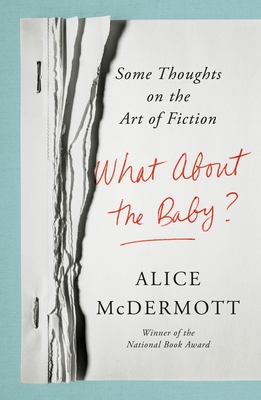What About the Baby? Some Thoughts on the Art of Fiction by Alice McDermott
- Farrar, Straus and Giroux, 2021
- Hardcover, 256 pages
- ISBN978-0-3741-3062-6

I don’t write fiction, but I do enjoy reading it. I also enjoy reading about the writing of fiction, because understanding the issues that writers consider about their writing process makes me a more competent reader and critic.
I grabbed this book when I saw it on the “Featured” shelf at the library. I was a bit disappointed once I finished it because it comprises a series of pieces—essays, lectures, workshop talks, and teaching notes—collected, apparently unedited, for book publication. There’s much of interest here, but the book features a few core ideas repeated over several sections.
One of those core ideas is the emphasis on character as the driving force in fiction: “I expect fiction to reject one-dimensional characters, easy stereotypes, ready-to-hand clichés” (p. 13). McDermott writes that a novelist shouldn’t try to impose her own ideas—or Ideas—on her work but should instead be true to the characters and their story: “Many of the characters I am most drawn to in my reading, and in my writing life, are full of questions, not answers” (p. 174).
A second core idea is the importance of language in writing fiction. McDermott makes this point with the following contrast:
“Journalists and memoirists use words to tell the story of something that has already happened, and for them one word may be as good as another, but fiction writers use words to evoke story out of thin air—the words themselves an incantation, not a report—and so the tale cannot be separated from the words with which it is told” (p. 124).
As a writer of nonfiction, I don’t agree with this evaluation. I also labor over the choice of each word, the juxtaposition of sentences, the coherence and organization of paragraphs. Good writing is good writing, whether the product is fiction or nonfiction.
A third core idea in McDermott’s book is the question of whether artistic creation can be taught. Here’s her take on the issue:
“In my years of teaching and writing, I have discovered that there is no surer formula for the failure of a story or a novel than the author’s certainty—from the beginning and throughout the process—that he or she knows, knows from the outset the story’s beginning and end and every permutation of character and plot. The confident writer, the control-freak writer, the writer who cannot let go of his plan, is sure to be the writer whose work will remain pedestrian, predictable, uninspired” (p. 182).
While I’m glad I read this book, I found it repetitious, full of generalities, and therefore a bit lightweight. I’ll leave you with a few more of McDermott’s statements.
Quotations
“Stories we return to not so much for solace as for the way the moment, the sentiment—fleeting tragedy, fleeting triumph—is made fully retrievable, forever, by language, by art: this is what I expect of fiction” (p. 10).
“I expect fiction to be about the pain and sweetness of life” (p. 11).
“I expect fiction to be about lives that are not my own” (p. 12).
“Put simply: We look for what the novel says that’s true for us all. We look for us” (p. 39).
“What is memorable [in a novel], then, is not the saga of how the author knew, or didn’t know, the story when she began to compose it. What is memorable is the sense of inevitability, of nothing superfluous, nothing wasted, of meaning and consequence revealing itself, resonating, page after page after page, in the completed work” (p. 102).
© 2022 by Mary Daniels Brown


I’m not impressed by the quotes you’ve sited, particuarly the one about use of language in fiction versus nonfiction. It’s simply not true.
I agree, Liz. And these are the most salient quotations. I almost felt cheated, really, after I’d read the whole book (which is quite short). The book was obviously put together from various earlier work, with nothing at all done to edit, update, or even smooth out transitions between the separate pieces.
From your review, I would say that the subtitle, “Some Thoughts on the Art of Fiction,” is telling. “Some thoughts” do not a book make.
*cited
Pingback: Nonfiction November: (Semi) Wrap-Up - Notes in the Margin
Pingback: “The Hidden Machinery” by Margot Livesey - Notes in the Margin